CAA News Today
CAA Signs ACLS Statement on Florida House Bill 999
posted by CAA — Mar 07, 2023
CAA has signed on to a statement issued by the American Council of Learned Societies (ACLS) regarding Florida HB 999. This bill would radically shift Florida’s approach to higher education in a manner that negatively impacts diversity and academic freedom; this is antithetical to CAA’s mission.
CAA stands with ACLS, together with other academic societies, and shares their belief that, if passed, the bill “ends academic freedom in the state’s public colleges and universities, with dire consequences for their teaching, research, and financial well-being.”
The full ACLS statement on Florida HB 999 can be viewed here. CAA encourages individual and institutional members to visit the ACLS website and sign on to the ACLS statement, as well as contact legislators, write op-eds, and proliferate information on social media to fight this bill.
Other learned societies and higher education institutions who have signed the ACLS statement:
American Academy of Religion
American Anthropological Association
American Association for Italian Studies
American Folklore Society
American Historical Association
American Musicological Society
American Philosophical Association
American Political Science Association
American Society for Environmental History
American Sociological Association
Association for Slavic, East European, and Eurasian Studies
Association for the Study of African American Life and History
Association of University Presses
College Art Association
German Studies Association
Latin American Studies Association
Linguistic Society of America
Medieval Academy of America
Modern Language Association
National Council of Teachers of English
National Council on Public History
National Women’s Studies Association
Organization of American Historians
Rhetoric Society of America
Sixteenth Century Society & Conference
Society for Ethnomusicology
Society for Music Theory
Society for the History of Technology
Society of Biblical Literature
World History Association
CAA has also signed on to a Florida HB 999 statement issued by the American Historical Association (AHA) which can be viewed here.
Other organizations who have signed the AHA statement:
African American Intellectual History Society
American Anthropological Association
American Association for the History of Medicine
American Association of University Professors
American Folklore Society
American Philosophical Association
American Society for Environmental History
American Sociological Association
Association for Slavic, East European, and Eurasian Studies
Association for the Study of African American Life and History
Association of Ancient Historians
Association of University Presses
Berkshire Conference of Women Historians
Black Heritage Trail of New Hampshire
Central European History Society
College Art Association
Committee on LGBT History
Conference on Latin American History
Executive Committee of the Czechoslovak Studies Association
French Colonial Historical Society
German Studies Association
H-France
Historians for Peace and Democracy
Immigration and Ethnic History Society
Kurt Vonnegut Museum and Library
Labor and Working Class History Association
LGBTQ History Museum of Central Florida
Linguistic Society of America
Medieval Academy of America
National Association of Diversity Officers in Higher Education
National Council on Public History
National Council of Teachers of English
New England Historical Association
North American Conference on British Studies
North American Society for Oceanic History
Organization of American Historians
PEN America
Polish American Historical Association
Radical History Review
Roy Rosenzweig Center for History and New Media
Shakespeare Association of America
Social Welfare History Group
Society for Austrian and Habsburg History
Society for French Historical Studies
Society for Historians of the Gilded Age and Progressive Era
Society for Textual Scholarship
Society for the History of the Early American Republic
Society for the History of Technology
Society for the History of the Early American Republic
Society for U.S. Intellectual History
Southern Historical Association
Texas Institute of Letters
Tully Center for Free Speech at Syracuse University
Western Society for French History
Woodhull Freedom Foundation
World History Association
Meet the Michael Aurbach Fellowship for Excellence in Visual Art Inaugural Recipient and Honorable Mentions
posted by CAA — Mar 07, 2023
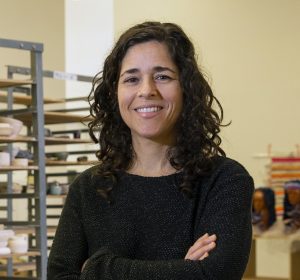
CAA is pleased to announce the first ever recipient of the first Michael Aurbach Fellowship for Excellence in Visual Art: Lauren Sandler.
Lauren Sandler is a ceramic artist and educator whose work deconstructs mythologies and investigates narratives of power and perspective. Sandler exhibits nationally, and gives talks, workshops, and publishes work concerning contemporary and historic issues in ceramics. She holds an MFA in Ceramics from Penn State University, and undergraduate degrees in Anthropology and Ceramics from Ithaca College and SUNY New Paltz. She served on the Board of the National Council on Education for the Ceramic Arts as Director at Large from 2019–22 and is currently Associate Professor and Program Head of Ceramics at Tyler School of Art and Architecture at Temple University.
HONORABLE MENTIONS
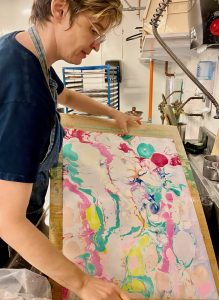
Ellen Wetmore, University of Massachusetts Lowell
Ellen Wetmore is a Professor of Art and Chair of the Department of Art and Design at the University of Massachusetts, Lowell. She is a graduate of the University of Michigan (BFA, BA in Art History) and Tufts University/School of the Museum of Fine Arts (MFA), and joined UMass Lowell in 2007. She is a participant of CAA, UFVA, Cultivamos Cultura, and past member of the Boston Sculptors Gallery. Her awards include a 2017 Berkshire Taconic ART Fellowship and a 2017 Massachusetts Cultural Council Fellowship. Her social concerns include neuro-atypical disabilities, race and teaching, money and art. Wetmore’s current artistic practice reinterprets history, art history, and investigates visual thinking. Wetmore’s projects have been featured at the Boston Cyberarts Art on the Marquee, the Indianapolis Art Center, the Sandwell Arts Trust, Ciné Lumière, London, CologneOff, Germany, the InShadow Festival, Lisbon, and Videoholica in Bulgaria. She is a 2012 School of the Museum of Fine Arts Traveling Fellow and a summer 2015 visiting artist at the American Academy of Rome. Her most recent solo exhibition was a drawing study of the collection at the Fitchburg Art Museum. Her current science collaborations explore printed, fabric-based video displays, text and memory in fat cells, and the characterization of high fire ceramic glazes in a Cambodian wood fired kiln. Her first graphic novel, Dante’s Inferno, is a fictional account of race and the academic hiring process.
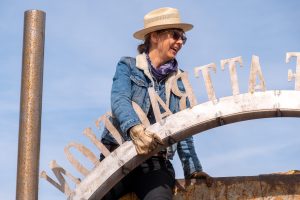
Allison Wiese, University of San Diego
Allison Wiese is an interdisciplinary artist who makes sculptures, installations, sound works, performances, and architectural interventions. Her work is often created for public spaces at the boundaries of or outside institutions, and has been exhibited at, among other venues, Machine Project, Los Angeles, the Museum of Contemporary Art, San Diego and Socrates Sculpture Park, New York. She is the recipient of a Louis Comfort Tiffany Award and has received grants from Art Matters, Creative Capital, the Cultural Arts Council of Houston, and the City of San Diego’s Commission for Arts and Culture. A fellow of MacDowell and an alumna of the Skowhegan School of Painting and Sculpture, Wiese was a Core Fellow of the Museum of Fine Arts, Houston, received her MFA from the University of California, San Diego, and a BA from Brown University. Wiese is an Associate Professor at the University of San Diego.
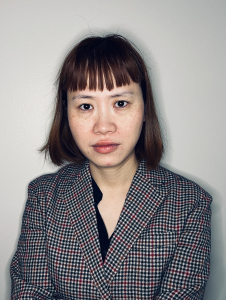
Ziui Vance, Temple University
Ziui explores the semiotics of bodies, their chaotic signals, and spatiality. She makes the paintings, objects, and installations inside the disputed realm between affection and dominance, rules and reality. Characterized by a play-like process, Ziui describes a variety of body configurations with an intricate intensity that reflected on gender, ethnicity, and perceptions: an infinite tapestry of imagery associated with her exoneration from the polar complexities of being Chinese in the United States.
ABOUT THE FELLOWSHIP
The Michael Aurbach Fellowship for Excellence in Visual Art recognizes and honors CAA members who have obtained an MFA or equivalent in studio art and are currently teaching studio classes full-time or part-time. The purpose is to support these artist members as they fulfill their goals as visual arts professionals. On an annual basis, CAA will grant a $7,500 award and registration to the CAA Annual Conference to a qualified artist member teaching at an American or international university or community college. A jury of artists will adjudicate the fellowship and a proposal will not be required; the recipient will be selected solely based on their work. Learn more.
CWA Picks: Spring 2023
posted by CAA — Mar 06, 2023
The CAA Committee on Women in the Arts (CWA) Spring Picks focus on exhibitions and literature that explore an interrelatedness of art and science. From the science of future technology to the science of biology, these artists utilize traditional and technological materials in their heterogeneous work.
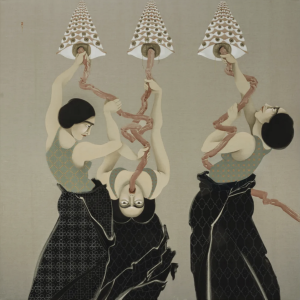
Hayv Kahraman, Eye megaphones, 2023, Oil and torshi on linen, 177.8 x 177.8 x 6.4 cm
Hayv Kahramen, February 6 – March 25
Third Line Gallery, Dubai
Occupying both gallery spaces, Hayv Kahraman presents a series of new paintings and drawings that continue her ongoing scientific research and exploration into the effects of trauma on the body, and the role of the gut in our healing process.
Kahraman’s practice is heavily guided by her refugee experience, where notions of gender and trauma are consistent themes throughout her work. Recently, the artist has directed her research towards neuroscience, human immunology and “neurosculpting” – the ability to restructure the neural pathways in our brain through the gut microbiome – and how they specifically relate to trauma, and our ultimate goal to heal and repair.
Often referred to as the body’s “second brain”, the gut is responsible for our somatic state whereby the bacteria inside our gut regulates the hormones that control our feelings. Kahraman became increasingly fascinated with this theory, and how neurosculpting offers the potential to heal through the process of unlearning and relearning. In this body of work, Kahraman applies this theory alongside her own lived experiences to highlight the puissant connection between the mind and the body. Exposed and tangled digestive organs act as a visual metaphor of unraveling the restorative process.
Delving further into the gut microbiome as a site for recognition and renewal, Kahraman addresses the notion of “otherness” through the medium in which she paints. We have learnt to consider the bacteria and foreign microbes found inside our gut as undesirable, but in fact they are fundamental to our human psyche. By incorporating into her paintings the lilac dye from torshi – fermented beetroot served in Middle Eastern cuisine which is believed to improve mental wellbeing via the gut, and jars of which are on view in the exhibition – Kahraman affirms that the microbial world is verification of our acceptance of difference. Physically painting with torshi – i.e. bacteria – serves as an allegory to how we sentient beings live in symbiosis with the “other”.
Sarah Sze, March 31 – September 10
Solomon R. Guggenheim Museum, NY
Organized by Kyung An, Associate Curator, Asian Art, and was conceived and contributed to by Nancy Spector, former Jennifer and David Stockman Chief Curator.
The Solomon R. Guggenheim Museum will present a solo exhibition of Sarah Sze (b. 1969, Boston) featuring a series of site-specific installations by the acclaimed New York–based artist. Sarah Sze: Timelapse will unravel a trail of discovery through multiple spaces of the iconic Frank Lloyd Wright building, from the exterior of the museum to the sixth level of the rotunda and the adjacent tower level gallery. The exhibition will explore Sze’s ongoing reflection on how our experience of time and place is continuously reshaped in relationship to the constant stream of objects, images, and information in today’s digitally and materially saturated world.
Sze creates across multiple mediums employing painting, sculpture, drawing, printmaking, video, and installation. She is well known for her intricate constructions using a myriad of both fabricated and found objects and images. Whether an intimately scaled sculpture or a large, permanent public commission, her works possess a generative quality—as though in a cycle of growth and decay—and dynamically engage with the spaces they occupy.
In Sze’s reimagination, the Guggenheim’s iconic, UNESCO World Heritage architecture becomes a public timekeeper in a reminder that timelines are built through shared experience and memory. In the words of the artist, “Like the collective efforts used by humans over centuries to communally mark time, to measure and mark it in physical form—ranging from Jantar Mantar, to the Prime Meridian line, to ubiquitous minarets, clock towers, and animated or astronomical clocks around the world—the museum building will become a site to explore the idea of a public clock, and an experiment in collective timekeeping that all in the city can experience.”
Inside the museum, quiet gestures, such as a single pendulum hovering above the fountain on the rotunda floor and a small sculptural installation tucked into an interstitial space in front of the freight elevator, demonstrate Sze’s distinct engagement with unexpected spaces. Visitors will enter an immersive environment: a panoramic sequence of eight bays occupied by a new series of works comprising painting, sculpture, video, drawing, and sound. These will be connected by a river of videos—seen earlier on the building’s street-level facade—which slowly travels up the spiral expanse of the building’s interior, creating a horizon line of moving images. As it travels across, above, and behind the works on view, visitors will be absorbed into a generative experience, continually re-orienting themselves temporally and spatially.
Kopotu Ipikosi (And They Overcame)
Pamela Enyonu, February 28 – March 28
AKKA Projects, Dubai
What is Fear?
Why do we Fear equality?
How does this Fear of achieving equality express itself in and around me?
This artistic essay is an exploration of the phenomenon of fear, and the positions it is experienced from; the instigation of fear and the effects it has on individual bodies and entire communities. What are the elements that create fear, how do the instigators of fear experience it and weaponise fear to curtail autonomy, and how is this activity systemised because it grows in scope and effectiveness; mass hysteria.
The artistic intervention aims to assess whether the effects of fear can be countered or even anticipated and to study the damage fear has on the quality of human expression. Pamela Enyonu was born in 1985 in Kampala, Uganda where she currently lives and works. Pamela studied Art and Design at the Kyambogo University Banda of Kampala, Uganda. Her artistic career started in 2017 with a 3 months residency at 32 degrees East, in Kampala, where she navigated the politics of identity, trauma, and healing. After her residency, she was invited to host a solo exhibition in June 2017. Another artist’s residency in Paris, France, followed in 2020, on the occasion of Africa 2020. In 2022, Enyonu has concluded her residency at AKKA Project in Venice, Italy, also being hosted by ProHelvetia, Zurich, Switzerland, in the same year.
Pamela’s style is inspired by stories, materials, and the process it takes to transform them into works of art. Her works present a tactile and 3-dimensional quality that richly layered textures exploring narratives on gender, identity, empowerment, and self-awareness. Pamela is particularly interested in the “untokenized” experiences occupying the intersection of empowerment, mental health, and identity. She continuously engages with the different communities through collaborations, workshops and seminars. Recently, some of Pamela’s latest works have been acquired by Africa First, and have become part of its private collection of contemporary African art.
Jennifer Chen , February 10 – April 30
Sci Arc, Los Angeles
No Evil imagines a long distant future when, after planetary scaled geoengineering systems have saved earth’s population from climate extinction, planet surviving events have become new creation stories: “machines that once filled the air, sown the seeds, fertilized the ocean, and dimmed the sun have long since been decommissioned.”
Exploring a world that was once on the brink of collapse, “saved only by the forgotten creatures of the past,” Chen is interested in using radical geoengineering processes as a lens through which we can investigate practical responses to climate restoration.
Using 2D and 3D data corrupting techniques to simulate the fading of memories across time and a mixture of analogue techniques including weaving, sewing, welding, and casting, as well as digital fabrication techniques including 3D printing and CNC milling, the exhibition combines decayed digital data and new cultural curiosities to imagine a world where new mythologies are created, giving rise to a new form of craft. Audiences will wander through an abstract forest landscape drawn from this future and encounter fragments of worship, shrines, tapestries, and stories told through film and objects. No Evil invites viewers to consider the forgotten tales, myths, and artifacts that once celebrated and revered these speculative relics of climate resistance as a reminder of what future could await us all if today, we turn a blind eye and cover our ears.
Chen is faculty at SCI-Arc and an architect and designer who works at the intersection of science and fiction, exploring themes of geoengineering, remote sensing, and climate change futures in projects that take the form of buildings, installation, film, and performance. Her new exhibition imagines a long distant future when, after planetary scaled geoengineering systems have saved earth’s population from climate extinction, planet surviving events have become new creation stories.
Tia Keobounpheng , July 22 – October 9
US Bank Gallery, The Minnesota Arts Exhibition Program
A Finnish and Sámi descendent, Keobounpheng uses her artistic practice to recognize her familial connections to both the colonizers and the colonized. “Revealing Threads” will feature her abstract tapestries, influenced by traditional Nordic handwork techniques but infused with contemporary interpretations and symbolism. The results speak to marginalized histories, heritage, and the complexity of personal identity. The works will be informed by a research trip to Sápmi, the traditional land of the Sami people, in fall 2022.
Keobounpheng is a designer/maker and artist living and working in North Minneapolis. She is a recipient of the 2017 and 2020 MN State Arts Board’s Artist Initiative Grant, 2018 McKnight Foundation’s Next Step Fund, and 2022 MN State Arts Board Creative Support for Individuals Grant. Her work has been shown at the American Swedish Institute, in Minneapolis; the Finlandia University Gallery, in Hancock, Michigan; the University of St. Thomas, in St. Paul; and the Anderson Center, in Red Wing, Minnesota. Her laser-cut jewelry has been sold by design retailers across the country for over a decade.
Fran Siegel , January 14 – March 4
Wilding Cran Gallery, Los Angeles
Curated by Jill Moniz
Chronicle features 216 small drawings on paper that Siegel started at the onset of the COVID-19 pandemic. Fran visualized the discourse around the virus as extensions of her focus on pinwheel and maps, as a shorthand of place, and the aesthetics approaching abstraction. Moniz pairs these ephemeral works with Siegel’s painted tapestries that incorporate porcelain as armatures, structural hardware that deciphers colonial appropriation and cultural production.
The exhibition offers multiple entry points into dialogues that magnify how making transforms moments, from staged and beautiful, to essential and abject. Siegel’s works are intimate in scale, reflecting how the pandemic dictated her process and inspired introspective collaging of dreams, news and opportunities, unpacking and reassembling iconography that influences how we interpret and shape our worlds.
In her consideration of patterns and pinwheels, Siegel draws out form, emphasizing how we record our relationship to each other and the landscape, and how intricately and intimately connected we are. Siegel’s pinwheels represent for Moniz a fulcrum of visual language that expands and focuses our attention on both specificity and plurality of experiences that benefit from collective empathy. Chronicle explores Moniz and Siegel’s shared commitment to the depth and complexity of cultural associations foundational to place, and meaning making through art practice.
The Art of Gilah Yelin Hirsch
Literature/publication
curated and edited by Donna Stein
A retrospective survey of the Canadian American artist’s career.
Characterized by a search for meaning, Hirsch’s oeuvre connects psychological, scientific, and philosophical implications of form, bringing together ideas in art, science, ecology, and human consciousness.
The artworks in multiple and mixed media provide an evolving history of Hirsch’s ideas and craft as they illustrate the progression of her original research on the origin of all alphabets. Her elegant theory about five fundamental shapes in nature that reflect forms of neurons and neural processes of perception and cognition as the source of all letterforms in alphabets ancient to modern has gained acceptance in scientific circles. Her evidence shows that while cultures and languages bring unique beauty and richness to the world, we, as humankind, are more alike than different.
Since the 1980s, Hirsch has also been a pioneer in the field of mind/body healing, developing a type of visualization practice that serves as an instrument toward wellness. By organizing seemingly disparate information into a far-reaching scientific theory, Hirsch is recognized internationally for these techniques and has advanced healing practices through the arts.
Archaeology of Metaphor connects the artist’s visual themes to her philosophy and ideas, simultaneously encouraging greater awareness of pattern recognition, social dynamics, and interconnectedness.
Jessi Reaves: All possessive lusts dispelled
The Arts Club of Chicago
Chicago, IL
February 16-May 20
Jessi Reaves combines iconic modernist design with an irreverent aesthetic in sculpture that toys with functionality. Reaves often begins with found furniture, which she dismantles, converts, remakes, enhances, pads, and embellishes in ways that still allow the suggestion of physical contact or use. By breaking things open, she proposes that they be examined visually and in terms of their purpose in life. The exhibition at The Arts Club of Chicago centers on the work Personal Heat, 2021, a deconstructed étagère with accompanying video that explores themes of renovation and rebellion. The sculptural aspect features a pop punk aesthetic of hot pink animal stripes, as if Reaves had been locked in a room in her great aunt’s house with a can of paint, a saw, and some wood glue. The funk and humor of this work and other of Reaves’s sculptures and wall reliefs belie a mastery of complex composition, color, and the ability to integrate disparate materials. Reaves brings to her seemingly off-handed works a range of manual skills that she uses to both humorous and unsettling effect. Jessi Reaves: all possessive lusts dispelled offers a sensuous installation of works that allow the abject to infiltrate the ontology of the object.
The Taxonomy of Peggy Macnamara
March 9–April 28, 2023
Glass Curtain Gallery—Columbia College Chicago
1104 S Wabash Ave, 1st Floor, Chicago, IL 60605
The Taxonomy of Peggy Macnamara features an immense array of artwork that has been created during Macnamara’s tenure as the only artist in residence at the Field Museum. This exhibition focuses on her relationship to observing and working among the collections over decades where practice as an artist, teacher, and collaborator has developed a process of long looking that has created a taxonomy of its own.
Macnamara has traveled across the world, geared with her pencils and watercolors, investigating the fascinating intricacies of nature alongside scientists and peers from the Field Museum. Although her work uses the academic approach of illustrating, her savvy is evident in her loose handling of her art materials to document plants, animals, and related conservation work. Macnamara’s work artfully captures living things (or in some cases—once living), educates us, and sparks interest in the complexities of the natural world.
This exhibition hones in on a tapestry of works that inspire curiosity and deep looking at plants, animals, and the dynamic relationships between them. Macanamara’s attention to detail, and skilled hand at analytically dissecting plants and animals is revealed through the works that leave the stages of the development of a piece visible. We engage with her work for the love of looking, but inevitably discussions about nature, extinction, conservation, and collections permeate its surface. Come take a peek behind the scenes of the Field Museum’s collections through Macnamara’s work, and through special tours accompanying this exhibition.
February 11-June 5th
Art Institute of Chicago
This exhibition brings together nearly 100 rarely seen woodblock prints by Pape, some of which have not been shown publicly since the artist exhibited them in the 1950s and 1960s. Composed of overlapping geometric and linear elements, they at times suggest the clash of atomic particles, rudimentary city plans, or slides of microscopic specimens.
CAA Signs On to NCAC Letter Regarding Arkansas Tech University Exhibition
posted by CAA — Feb 08, 2023
CAA has issued a joint letter with the National Coalition Against Censorship (NCAC) regarding a recent exhibition on display at Arkansas Tech University (ATU). The subject matter in the exhibit centers on issues of race and representations of troubling components of American history. After students of color voiced objections to the exhibition, the artist withdrew her exhibition.
We believe context is essential for artists to produce and display their work, and for others to consume that work with a critical gaze. The drafted letter states, in part, “by abdicating its responsibility as an educational institution to stand by its exhibition programming and actively create productive dialogue around it, the University has failed its students and the artist.” Previously, CAA collaborated with a number of agencies to create Museum Best Practices for Managing Controversy, a set of guidelines offering best practices for institutions “concerned about or confronted with accusations of inappropriate, objectionable, or offensive content.”
The full letter can be viewed here.
Meet the 2022 Professional Development Fellows
posted by CAA — Feb 07, 2023
CAA is pleased to announce the recipient of the 2022 Professional Development Fellowships. The recipient of the $10,000 fellowship in art history is Mechella Yezernitskaya, Bryn Mawr College, and the recipient of the $10,000 fellowship in visual art is Boone Nguyen, California State University, Los Angeles.
The honorable mentions in art history were awarded to Jack Crawford, City University of New York, and Astrid Tvetenstrand, Boston University. The honorable mentions in visual art are awarded to Jenna Carlie, California Institute of the Arts, and Alberto Lozano Ruvalcaba, Mendocino College.
2022 PROFESSIONAL DEVELOPMENT FELLOWSHIP IN ART HISTORY
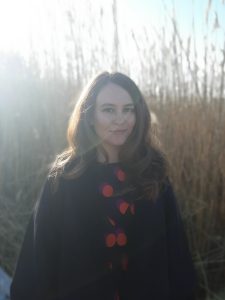
Mechella Yezernitskaya, Bryn Mawr College
Mechella Yezernitskaya is a Ukrainian American art historian, writer, and curator. She is a doctoral candidate in the Department of History of Art at Bryn Mawr College where she specializes in modern and contemporary art. Mechella received her M.A. from Bryn Mawr College and B.A. with honors in Art History from Fordham University. Her dissertation examines representations of temporal rupturing in the wartime visual, literary, and film culture of the avant-gardes of the late Russian Empire and the early Soviet Union. She examines war-related imagery in the work of artists of Belarusian, Russian, and Ukrainian origin across media including illustrated books, poetry, collage painting, performance, and film. By drawing upon theories from trauma and disability studies, Mechella explores the roles of the civilian and combatant, the temporal boundaries of wartime and peacetime, the consequences of imperialism, the rise of nationalism, and the affective experiences of war.
Her work has been supported by grants and fellowships from the American Association of University Women, the Association of Slavic, East European, and Eurasian Studies (ASEEES), the Pittsburgh Foundation, the Malevich Society, the New York Public Library, and the Graduate School of Arts and Sciences of Bryn Mawr College. She has published in ARTMargins Online, Baltic Worlds, post: notes on art in a global context, Slavic & East European Information Resources, and in the edited volume Artistic Expressions and the Great War, A Hundred Years On (Peter Lang Publishing, 2020). She has presented her research at Södertörn University, Stockholm; Karazin University, Kharkiv; Hofstra University, New York; Temple University, Philadelphia; The Museum of Russian Art, Minneapolis; and ASEEES. She has also held guest curatorial positions and fellowships at The Museum of Modern Art, the Philadelphia Museum of Art, the Pennsylvania Academy of the Fine Arts, and the Brooklyn Museum.
HONORABLE MENTIONS IN ART HISTORY
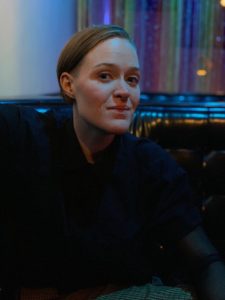
Jack Crawford, City University of New York
Jack Crawford is a teaching artist and art historian. She is currently a Lecturer at Vanderbilt University and University of Tennessee, Knoxville and has previously taught at the New York City College of Technology. She holds a BA from Barnard College and is currently completing her PhD in Art History at the CUNY Graduate Center. Her research, for which she received a 2021–2022 ACLS/Luce Dissertation Fellowship in American Art and a dissertation award from the CUNY Committee on Globalization and Social Change, focuses on appropriation and aesthetics of abundance in queer performance in the postwar period.
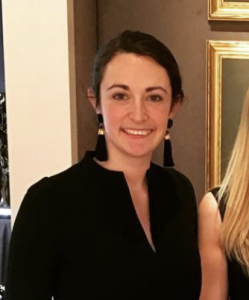
Astrid Tvetenstrand, Boston University
Astrid studies the history of American painting, decorative arts, and architecture. She explores these fields through practices of collection, economic development, and the consumption of American property. Her dissertation traces the connections between American art patronage, second homeownership, and landscape painting at the end of the nineteenth century. She argues that the process of collecting art and land was an effort made by affluent Americans to “buy a view.” By recognizing landscape paintings as investments and monetary goods, Astrid sheds new light on Gilded Age consumerism, aesthetics, and taste. She also localizes art market exchanges within a larger conversation about the privatization of public space.
Astrid’s work is encouraged by positions and fellowships held at the New York Public Library, Museum of Fine Arts, Boston, Massachusetts Historical Society, Nichols House Museum, Bundy Museum of History and Art, Peabody Essex Museum, deCordova Sculpture Park and Museum, Decorative Arts Trust, and Winter Antiques Show.
2022 PROFESSIONAL DEVELOPMENT FELLOWSHIP IN VISUAL ARTS
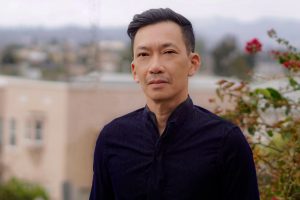
Boone Nguyen, California State University, Los Angeles
Boone Nguyen is an artist of the Southeast Asian diaspora. When he was a child, his family left Saigon and resettled as refugees in South Philadelphia. His experience as a refugee in the metropole informs his work through the themes of displacement and place-building, landscape and historical memory, leaving and returning, loss and transformation. His immersive moving image installations are thus fueled by a continuing search for a distant yet familiar homeplace, where the intimacies of life and death and the dialectic of subjection and resistance serve as a living archive of critical memory that is both personal and collective. He has exhibited his work in Philadelphia, Honolulu, Minneapolis, Los Angeles, and Tokyo.
Boone Nguyen has served in curatorial and management positions in community arts organizations, including Asian Arts Initiative, Frameline, and Scribe Video Center. He holds a BA in American Studies (minor in Asian American Studies) from Yale University. As a Cota-Robles Fellow, he earned an MA in Ethnic Studies at the University of California, San Diego. He was a recipient of a 2018/19 MCAD–Jerome Foundation Fellowships for Early Career Artists, administered by the Minneapolis College of Art and Design and funded by the Jerome Foundation. Nguyen is currently in his final semester of the MFA program at California State University, Los Angeles where he also lectures in the Asian and Asian American Studies Department.
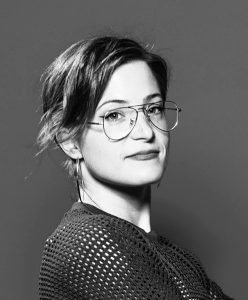
Jenna Carlie, California Institute of the Arts
Jenna studied photography at Speos Institute of Photography in Paris, France and went on to study at Rhode Island School of Design. During the time at RISD, Jenna worked under Annie Leibovitz, Mark Katzman, and Dusty Kessler. In 2016, Jenna graduated with a BFA in photography from Rhode Island School of Design. Jenna moved to Los Angeles and in 2017 worked for Lauren Greenfield, in 2018 worked for Alexa Meade, and by the end of 2018 Jenna Carlie Photography and Design was opened for business. Between 2018 and 2020 Jenna worked on various photographic series for different private collections in the Midwest. In 2020, the Saint Louis Art Museum hired Jenna as their travel contract photographer and later as their in-house photographer, where Jenna is still employed. Jenna is currently getting an MFA from California Institute of the Arts and is expected to graduate in 2024.
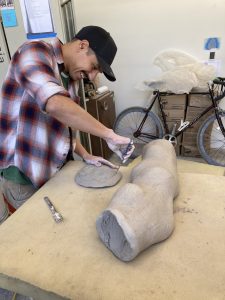
Alberto Lozano Ruvalcaba, Mendocino College
I was born in Tijuana, Baja California in 1993. My family lived in Rosarito next to the beach on a street called Niño Artillero (artillery child). My school was named after Emiliano Zapata, a leader of the Mexican revolution. My parents moved us to the USA when I was eight years old. We left everything behind except for each other and the memories that persist of our home and of the natural landscape around it. They brought us to this country for my siblings and I to have a better future than what was available back home. Thanks to my parents and siblings and my own perseverance, I am now the first person in my family to pursue a master’s degree from a university. I am now a permanent resident of the USA and a candidate for an MFA degree.
ABOUT THE PROFESSIONAL DEVELOPMENT FELLOWSHIP
CAA’s Professional Development Fellowship program supports promising artists and art historians who are enrolled in MFA and PhD programs nationwide. Awards are intended to help them with various aspects of their work, whether for job-search expenses or purchasing materials for the studio. CAA believes a grant of this kind, without contingencies, can best facilitate the transition between graduate studies and professional careers. The program is open to all eligible graduate students in the visual arts and art history. Learn more.
CAA 2023 Awards for Distinction
posted by CAA — Feb 06, 2023
CAA announces the 2023 recipients of Awards for Distinction. By honoring outstanding member achievements, CAA reaffirms its mission to encourage the highest standards of scholarship, practice, connoisseurship, and teaching in the arts. With these annual awards, CAA seeks to honor individual artists, art historians, authors, museum professionals, and critics whose accomplishments transcend their individual disciplines and contribute to the profession as a whole and to the world at large.
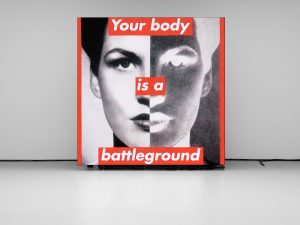
Installation view, Barbara Kruger, David Zwirner, New York, June 30–August 12, 2022. Courtesy David Zwirner.
Among the awards, the Distinguished Artist Award for Lifetime Achievement is presented to Barbara Kruger whose influential works have consistently had viewers question the larger society around them for over four decades.
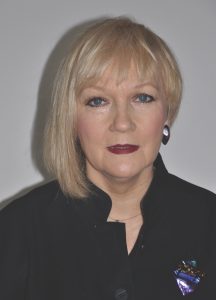
Griselda Pollock
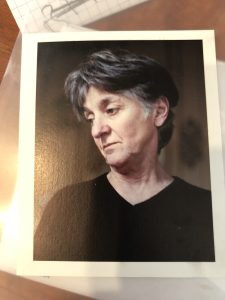
Svetlana Alpers
The Distinguished Lifetime Achievement Awards for Writing on Art are being presented to feminist art historian Griselda Pollock and art historian of northern Renaissance and Dutch Golden Age art Svetlana Alpers.
Art Journal Award
Alfred H. Barr Jr. Award
Julia Burtenshaw, Héctor García Botero, Diana Magaloni, and María Alicia Uribe Villegas, The Portable Universe / El universo en tus manos: Thought and Splendor of Indigenous Colombia (DelMonico Books/Los Angeles County Museum of Art, 2022)
Alfred H. Barr Jr. Award for Smaller Museums, Libraries, Collections, and Exhibitions
No recipient this year
Frank Jewett Mather Award
Eduardo Cadava
Charles Rufus Morey Book Award
Sylvia Houghteling, The Art of Cloth in Mughal India (Princeton University Press, 2022)
Arthur Kingsley Porter Prize
Tomasz Grusiecki, “Doublethink: Polish Carpets in Transcultural Contexts” and Hugo Shakeshaft, “Beauty, Gods, and Early Greek Art: The Dedications of Mantiklos and Nikandre Revisited”
Artist Award for a Distinguished Body of Work
Dawoud Bey
CAA/AIC Award for Distinction in Scholarship and Conservation
Michele Marincola and Lucretia Kargère
Distinguished Artist Award for Lifetime Achievement
Barbara Kruger
Distinguished Lifetime Achievement Award for Writing on Art
Svetlana Alpers and Griselda Pollock
Distinguished Teaching of Art Award
Mary Lum
Distinguished Teaching of Art History Award
No recipient this year
Excellence in Diversity Award
Arlene M. Dávila
Citations:
Art Journal Award
Emilie Boone, “When Images in Haiti Fail: The Photograph of Charlemagne Péralte,” Art Journal, Winter 2022
The 2022 jury has chosen Emilie Boone as the recipient of the 2022 Art Journal Award for the essay, “When Images in Haiti Fail: The Photograph of Charlemagne Péralte.” Boone’s deconstruction of a single photo offers readers an entry into the contested history surrounding the US occupation of Haiti, as well as the attendant visual politics of this period (1915–34). Through close textual analysis of Péralte’s historically significant image, the author weaves together a situated narrative of Haitian visual culture under occupation, interrogating crucial notions of ontology through examination of photographic composition. Boone frames the racialized body as a contested and imagined site rife for adaptation and tampering, first through vernacular photographic techniques, as well as other forms of pictorial representation. In the end, Boone’s text summons an interrogation of tradition, and indeed, of the implicit politics of the medium of photography itself.
Jury members:
Omar Kholeif, Sharjah Art Foundation, Chair
Phil Taylor, George Eastman Museum
Tilo Reifenstein, York St John University
Alfred H. Barr Jr. Award
Julia Burtenshaw, Héctor García Botero, Diana Magaloni, and María Alicia Uribe Villegas, The Portable Universe/El universo en tus manos: Thought and Splendor of Indigenous Colombia (DelMonico Books / Los Angeles County Museum of Art, 2022)
The Western concept of El Dorado has long impacted the study of the ancient cultures of Colombia, overshadowing the manifold stories that pre-Columbian art weaves across time and space. How can museum curators uncover those stories, illuminate their nuanced complexities, and present them to the public in engaging and innovative ways? The Portable Universe/El universo en tus manos is the remarkable outcome of just such an undertaking. Both the catalog and related exhibition are the result of a six-year collaboration between the Los Angeles County Museum of Art and Museo del Oro, Bogotá. Most importantly, the curators collaborated with a contemporary Indigenous community in Colombia, the Arhuaco of the Sierra Nevada de Santa Marta. The Portable Universe reveals that pre-Columbian artifacts—including goldworks, ceramics, and textiles—are not mere objects, but rather messengers that link living beings (people, animals, plants) and places across space and time. Each is, in brief, a portable universe. The Arhuaco explain that these messengers need to be “nourished,” or brought back to life. Thus, the concept of nourishment enters curatorial practice: a form of sustained, reciprocal attention that goes well beyond customary models of stewardship. Incisively written, gorgeously illustrated, and ingeniously designed, this groundbreaking book brings together interdisciplinary research (in history, archaeology, anthropology, environmental studies, and ornithology) and Indigenous knowledge to propose a new approach to the material and spiritual culture of ancient Colombia, one which underscores the transformative powers of cross-cultural dialogue. A major advance in the study of Indigenous art, the book spurs us to creatively rethink our notions of both the museum and scholarship.
Jury Members:
Benjamin Anderson, Cornell University, Co-chair
Karen Lang, Independent Scholar, Co-chair
Francesca Pietropaolo, Independent Scholar
Jochen Wierich, Aquinas College
Frank Jewett Mather Award
Eduardo Cadava
The jury has awarded this year’s prize to Eduardo Cadava, based on his elegant book Paper Graveyards (MIT Press, 2021) and in recognition of his long career within the field of art criticism, especially his influential theories of photography. Paper Graveyards is the culmination of decades of Cadava’s thinking about how images and technical media actively transform social and political life, and his far-ranging case studies (including examinations of artists Leon Golub, Nancy Spero, Fazal Sheikh, and Susan Meiselas) orient themselves towards activist practices that speak to and from the margins. Wending through ruminations on materiality, forms of documentary, and modes of circulation, Cadava writes a new account of what it means to pay visual witness in the face of constant emergency.
Jury members:
Julia Bryan-Wilson, Columbia University, Chair
Nicole Fleetwood, New York University
Kim Theriault, Dominion University
Charles Rufus Morey Book Award
Sylvia Houghteling, The Art of Cloth in Mughal India (Princeton University Press, 2022)
The Art of Cloth in Mughal India by Sylvia Houghteling focuses on the production, circulation, and consumption of South Asian textiles in the sixteenth and seventeenth centuries, a period of both global manufacturing dominance and intense artistic creativity for Indian cloth-makers. The book offers a uniquely comprehensive account of the complex meanings of cloth as it moved across the Mughal imperial courts, the kingdoms of Rajasthan, the Deccan sultanates, and the British Isles, all the while remaining attentive to the richness of regional specialties. Houghteling brilliantly weaves together a capacious range of topics including issues of patronage and labor, iconography and symbolism, technical and ecological considerations, connections with poetry and other fine as well as decorative arts, and the sensory experience of the various textiles, from gauzy muslins to tent panels. Starting with an account of the Emperor Akbar’s patronage of dyers and weavers, Houghteling analyzes the elaborate Bikaner Robe, which Akbar’s successor Jahangir presented to a provincial raja. She moves on to the elegant textile culture of the Rajput Court of Amber and the kalamkari cloth of Machilipatnam, ending with a survey of the flourishing market for Hindustani cloth in early modern Britain, evidence of a new global cosmopolitanism that linked the Mughal court with the Stuarts. The book’s handsome design, color illustrations, and vivid writing make Art of Cloth an engaging read for scholars and general readers alike.
Jury members:
Lisa Schrenk, University of Arizona, Chair
John Cunnally, Iowa State University
Laura Anne Kalba, University of Minnesota, Minneapolis
J. P. Park, University of Oxford
Andrew Wasserman, American University
Arthur Kingsley Porter Prize
Tomasz Grusiecki and Hugo Shakeshaft
Tomasz Grusiecki, “Doublethink: Polish Carpets in Transcultural Contexts,” The Art Bulletin, September 2022
That art objects move, and that in doing so their meaning changes, is now widely accepted, but conceptualizing and describing the ways in which such changes occur still often eludes us. Tomasz Grusiecki’s winning essay provides a framework for doing just that, in its elegant examination of the lives and plural significances of carpets in early modern Eastern and Central Europe. Borrowing George Orwell’s notion of “doublethink,” Grusiecki shows, with a keenly historical eye, that there was little tension for early modern patrons between the provenience of carpets in Safavid Persia or Ottoman Turkey and their adaptation into local European contexts, where they became fundamental to the construction of individual and burgeoning national identities. Grusiecki moves past the simple charting of the “surprising” provenances of individual objects to weave a complex web in which he embraces the inevitable messiness of movement—and of meaning—in early modernity. Grusiecki’s transcultural doublethink promises to be a concept of great utility for our discipline as it continues to grapple with these issues.
Hugo Shakeshaft, “Beauty, Gods, and Early Greek Art: The Dedications of Mantiklos and Nikandre Revisited,” The Art Bulletin, May 2022
In his groundbreaking article “Beauty, Gods, and Early Greek Art: The Dedications of Mantiklos and Nikandre Revisited,” Hugo Shakeshaft transforms narratives around the topic of beauty in the religious art of archaic Greece. He moves away from such still-influential Enlightenment frameworks as Kant’s account of aesthetic autonomy and Winckelmann’s concern with timeless aesthetic values to examine the question of beauty from a historicizing vantage point. In order to assess how beauty mattered for those who patronized, created, employed, and observed artworks in ancient Greece, Shakeshaft focuses on two anthropomorphic votive figurines—a bronze statuette dedicated by Mantiklos (ca. 700–675 BCE) and a marble life-size statue dedicated by Nikandre (ca. 660–630 BCE). In his deeply researched discussion, he reconsiders these celebrated objects through a layered analysis of their forms, inscriptions, and materials as well as by reading them alongside aesthetic values expressed in the writings of Homer and Hesiod. In particular, he calls attention to the ideal of charis, a rich concept that can be translated as “beauty,” “favor,” “gratitude,” and “grace,” to show how beauty was inextricably tied to ideas of reciprocity. Ultimately, Shakeshaft posits that beauty needs to be treated as rigorously as any other interpretive category, and—far from being a universal—demands contextualized cultural awareness.
Jury members:
Adam Jasienski, Southern Methodist University, Chair
Susanna Berger, University of Southern California
Christine I. Ho, University of Massachusetts Amherst
Artist Award for a Distinguished Body of Work
Dawoud Bey
Dawoud Bey has a photographic career spanning four decades, beginning in 1975 with the seminal five-year portrait project of everyday life in Harlem. His work has recently traveled in a retrospective titled An American Project” at the San Francisco Museum of Modern Art and co-organized by the Whitney Museum of American Art. In his recent publication, Dawoud Bey: Two American Projects, his work explores race, African American history and underrepresented communities; featuring portraits memorializing the six children who were victims of the Ku Klux Klan’s bombing at 16th Street Baptist Church in Birmingham, and a group of black-and-white landscapes made in Ohio where the Underground Railroad once operated. In the 1980s Bey collaborated with artist David Hammons by documenting the performances Bliz-aard Ball Sale and Pissed Off. In 2017 he received the MacArthur Fellowship and is Professor of Photography at Columbia College Chicago where he has taught for over twenty years. Bey’s work is in permanent collections of leading museums, including the Art Institute of Chicago, the Museum of Modern Art in New York, and the Whitney Museum of American Art.
Jury members:
Derek G. Larson, Purdue University, Chair
Stephen Fakiyesi, Independent Artist
Jessica Hong, Art Museum
CAA/AIC Award for Distinction in Scholarship and Conservation
Michele Marincola and Lucretia Kargère
Michele Marincola and Lucretia Kargère are recognized by conservators, curators, and art historians, for their contributions to the study of European sculpture. Their recent, joint publication titled The Conservation of Medieval Polychrome Wood Sculpture: History, Theory, Practice (Los Angeles: Getty Conservation Institute, 2020) is a major contribution to the fields and represents two-decades of collaborative work.
Marincola is the Sherman Fairchild Chair, and Sherman Fairchild Distinguished Professor of Conservation, at the Conservation Center, Institute of Fine Arts, New York University, a position she has held since 2014. Kargère is a Conservator of Medieval Sculptures at the Metropolitan Museum of Art and the Cloisters. Marincola previously worked with Kargère at the Cloisters where they collaborated on conservation and research. Marincola’s contributions to scholarship include research on the sculptor Tilman Riemenschneider and the translation and commentary of Johannes Taubert’s Farbige Skulpturen into English. Kargère, who is known for her work on French sculpture, has collaborated with Maricola and conservation scientists at the Metropolitan Museum of Art on the publications about the materials and techniques used in Medieval polychrome sculpture.
Both Marincola and Kargère are recognized for having educated students and colleagues about the history and conservation of European Medieval polychrome sculpture. Numerous students, interns, and Fellows have benefitted from their expertise both at the Metropolitan Museum of Art and at New York University. Moreover, Marincola and Kargère are known for producing publications and presentations that touch upon important issues in art conservation, art making, art history, and ethics.
Jury members:
Tiarna Doherty, University of Delaware and Smithsonian, Chair
Fernanda Valverde, Amon Carter Museum
Rebecca Rushfield, Rebeccah Rushfield Arts Consultants
Distinguished Artist Award for Lifetime Achievement
Barbara Kruger
Barbara Kruger’s distinct artistic practice has palpably shaped the broader social, cultural, and visual fields for decades. For over four decades, the artist has persistently expanded her practice, exploring new media, from video to large-scale installations, collaborating with popular brands (with some even co-opting her iconic visual language) extending her influence beyond the art world, to pursuing intrepid interventions in the public sphere. Best known for her works with bold, declarative, often imposing and seemingly authorless text in which she overlays appropriated black-and-white imagery, Kruger interrogates mass media and consumer culture’s effects on how we see and understand ourselves. As the artist expressed, “I work with pictures and words because they have the ability to determine who we are, what we want to be and what we become,” and she sees her works as prompts “to question and change the systems that contain us.” With the internet boom, explosion of social media, advertising’s increasingly sophisticated, if not untruthful, tactics, and advertising’s constant presence now from an infinite number of sources, Kruger’s work, past and present, feels more relevant than ever (as seen with numerous and recent solo presentations around the globe). Throughout her dedicated practice, Kruger has reminded us that these issues will continue to raise existential concerns and impact society writ-large until actively contended with.
Jury members:
Derek G. Larson, Purdue University, Chair
Stephen Fakiyesi, Independent Artist
Jessica Hong, Art Museum
Distinguished Lifetime Achievement Award for Writing on Art
Svetlana Alpers and Griselda Pollock
Renowned for her groundbreaking work on Dutch Golden Age painting, Svetlana Alpers’ writings have had a profound impact on the field of art history. A founder of the journal Representations and one of the central figures in the revisionist turn of the new art history, Alpers broke with long-standing approaches to northern European art by asking new questions about visual culture and ways of seeing. In The Art of Describing (1983), her questions about optics and image-making devices ignited scholarship in premodern and modern fields alike. In subsequent publications, Alpers’ notions about the monetary value of art materials and the marketing strategies of artists also proved fertile ground for later scholars. However, the Art of Describing did not only reinvent methodologies for understanding Dutch art, pushing against the field’s reliance on ideas forged in the study of Italian artistic practices; it recast what it means to “describe” art, the ekphrastic basis of our field, effecting the writing of art history ever since.
Professor Emerita from the University of California at Berkeley, where she taught from 1962–98, Alpers continues to publish across and redefine fields ranging from the Baroque to contemporary art and photography history. Widely known for Rembrandt’s Enterprise: The Studio and the Market (1988), which won CAA’s Charles Rufus Morey Book Award in 1990, Alpers has also penned field-changing monographs on Tiepolo, Rubens, and Velázquez. To this list, Alpers has added her latest book, Walker Evans: Starting from Scratch (2020), a monograph on one of the most important photographers of the twentieth century, and part of a subset of her writings that have confronted directly the challenges of photography, as The Art of Describing long ago became required reading in this field. Her recent publications such as Roof Life (2013) make concrete the writerly challenge that her work has always issued to art history, the need to reinvent “how” as well as “what” we say and write about art.
Arguably the leading feminist art historian of the generation after Linda Nochlin, Griselda Pollock first made an impact with a vigorous dissembling of the “artists mythologies and media genius” that attended the canonization of artists such as Vincent van Gogh. She went on to devote close attention to previously devalued women artists such as Mary Cassatt, Eva Hesse, and, more recently, in her innovative Virtual Feminist Museum, Charlotte Salomon. Essays such as “Modernity and the Spaces of Femininity” in her 1987 book Vision and Difference were powerful examples of her strategy of “feminist interventions” into the history of art, rather than falling for the trap of settling for the inclusion of women artists within the prevailing patriarchal structures.
The Award acknowledges this groundbreaking work as well as a wider, far-reaching achievement, ranging across several decades. Pollock’s writing has long refused to stay in its art historical place, to belong to a single position or way of working. Her brand of feminist revisionism constantly engages the social history of art, bridges art history with cinema studies, opens onto the fields of psychoanalysis and cultural geography, while also participating in the debates of postcolonial theory and responding to the imperatives of decolonization. While remaining attentive to the demands of each of these critical disciplines, her writing about art remains passionate, profound, open-hearted, and, always, political.
Jury Members:
Terry Smith, University of Pittsburgh, Chair
George Baker, University of California Los Angeles
Gillian Elliott, George Washington University
Distinguished Teaching of Art Award
Mary Lum
Mary Lum is CAA’s 2023 Distinguished Teaching of Art Award recipient. Lum, an accomplished visual artist in her own right, has been a professor of painting and drawing at Bennington College in Vermont since 2005, and prior to that taught at the New York State College of Ceramics at Alfred University. Among her many notable contributions as an educator is her ability to nurture a passion for art making in her students that has taken many of them from foundational studies, to graduate school, and to successful professional practices as artists, art directors, curators, and academic professors.
Steven Frost, Assistant Professor and Faculty Director, University of Colorado Boulder says of his time as a foundation student under Lum; “With her help I began to understand a creative practice needed to be fed by more than time in the studio . . . She took the time to bring me up to speed and prepare me for the professional world.”
Rebekah Modrak, foundation student, current professor University of Michigan, STAMPS School of Art and Design says of Lum “Thank goodness her main concern was the possibility that there might be compelling artists lurking below our early and often tenuous attempt at artmaking.” “When I think of moments in my life that changed my trajectory,” says former student and UK-based art director and curator Christine Serchia, “Mary Lum is responsible for multiple moments.”
CAA is excited to recognize Mary Lum’s more than two decades of teaching with this award.
Jury members:
Derek G. Larson, Purdue University, Chair
Stephen Fakiyesi, Independent Artist
Jessica Hong, Art Museum
Distinguished Feminist Awards
Nalini Malani and Marsha Meskimmon
Nalini Malani’s work has been recognized in solo exhibitions at over thirty international institutions. Her work has embraced painting, video, stop-motion, and other time-based media, while engaging issues of women’s equality in India, where her family took refuge in 1946 after the partition. Malani’s early career in painting gave way to a more focused approach to time-based media in the 1990s, making works such as the 1998 Remembering Toba Tek Singh, a meditation on nuclear testing in India and Pakistan. Focusing on the aftereffects of the devastating partition of India and Pakistan, Malani’s work has been liberal in its use of media types and productions, including the emotive devices of theater.
Malani has turned this unflinching attention to the ways in which the woman’s body has been used as a pawn in games of nationalism and internationalism. Her Mother India: Transitions in the Construction of Pain (2005) combined archival footage and other imagery, a series of juxtapositions that shed new light on the depicted contorted bodies of women. She continues this thread in a 2020 multimedia performance of images projected onto the Taj Mahal Hotel, inspired by the week-long gang rape and murder of an eight-year-old girl. Malani’s work is a beacon; her work is eminently important now as the world bears witness to an increase in femicide and gender-based violence.
Marsha Meskimmon, PhD is a professor of art history who studies, teaches, and writes on global feminisms. Her groundbreaking scholarly work has been matched by a commitment to promoting and mentoring women in the field. Meskimmon is editor for Drawing In, and she is also a consultant editor for Open Arts Journal. She has authored or co-authored twelve books over her career, with a sustained focus on the political stakes of feminism and its ability to shed light on the circulation of art and the discourse of aesthetics. With Amelia Jones, she edits the book series Rethinking Art’s Histories for Manchester University Press, a series that has promoted books that rethink art and its histories, and has used feminist thought in relation to “global” and non-Western approaches to art history. Her work on the exhibition WACK! Art and the Feminist Revolution marked an important return to feminism in the art world, a redefinition of the stakes and of the purview of its ideas. Her essay for the exhibition succeeded in arguing why feminism is global—describing it as a constellation of approaches, places, and times. It models an interdisciplinary and collaborative idea of feminism, not a static theory that spreads from the North Atlantic out to world. Her tireless work on behalf of women in the arts is a model for scholars who do their work out of a stated commitment.
Jury Members:
Delinda Collier, School of the Art Institute of Chicago, Chair
Yvonne Love, Penn State University
Midori Yoshimoto, New Jersey City University
Excellence in Diversity Award
Arlene M. Dávila
Arlene M. Dávila is Professor of Anthropology and American Studies at New York University and founding director of The Latinx Project. Established in 2018, The Latinx Project is an interdisciplinary space focusing on US Latinx Art, Culture and Scholarship. In addition to hosting artists and programs, it functions as a platform fostering critical public programming.
Professor Dávila’s has published extensively on Latinx cultural politics in museums and contemporary art, media, and urban environments to explore the intricacies and ultimate challenges of visualizing Latinx art and culture. Her research spans urban ethnography, the political economy of culture and media, consumption, immigration and geographies of inequality and race.
Professor Dávila’s publications, with a focus on public imagery and cultural politics, include Latinx art: Artists, Markets and Politics (Duke University Press, 2020), El Mall: The Spatial and Class Politics of Shopping Malls in Latin America (University of California Press, 2016), the revised edition of Latinos Inc: Marketing and the Making of a People (University of California Press, 2012), Culture Works: Space, Value, and Mobility Across the Neoliberal Americas (NYU Press, 2012), and Latino Spin: Public Image and the Whitewashing of Race (NYU Press, 2008). Dávila also co-edited the collection Contemporary Latina/o Media: Production, Circulation, Politics (NYU Press, 2014). Her articles have appeared in AZTLAN: A Journal of Chicano Studies and Centro: Journal of the Center for Puerto Rican Studies.
Carmenita Higginbotham, Virginia Commonwealth University, Chair
Anne H. Berry, Cleveland State University
Kelly Walters, Parsons School of Design
Meet the 2023 CAA Annual Conference Kress Travel Grant Recipients
posted by CAA — Jan 30, 2023
Recognizing the value of the exchange of ideas and experience among art historians, the Kress Foundation is offering support for scholars participating as speakers at the 2023 CAA Annual Conference. The scholarly focus of the papers must be European art before 1830.
Samuel H. Kress Foundation CAA Annual Conference Travel Fellows 2023
Presentation: “Ordering the Ground: Ornamental Parterres and the Emergence of Academic Botany”
Session: Making Green Worlds (ca. 1450–1700)
Lauren Cannady, University of Maryland, College Park
Rather than the depiction of scholarly work taking place in Sébastien Leclerc’s engraved headpiece for Denis Dodart’s Mémoires pour servir à l’histoire naturelle des plantes (1676), it is a scene of the direct observation of nature glimpsed through a window that is most striking. Three men stand in an arabesque-patterned parterre to more closely examine the individual plants that compose the garden. One uses his walking cane to point out a specimen—literally embedded in the undulating scrollwork of the parterre—to his companions. This ornamental plantation—or manner of “ordering of the ground” as Francis Bacon lamented in his essay “Of Gardens” (1625)—reflects the dominant style of contemporary aristocratic pleasure and academic botanic gardens across northern Europe. Such impositions of formal, physical order on the natural world, however, belie the acknowledged chaos of seventeenth-century natural history. Bacon, among others, contended that empirical observation could best be used to make sense of the “many things in nature [that] have been laid open and discovered,” including organic material from around the world collected by Europeans in the name of colonialism. The renewed emphasis on empiricism did little, however, to rectify linguistic confusion and imprecise nomenclature, particularly pressing issues for the emerging field of botany. As a repository for nonnative flora and living laboratory for the production of naturalist knowledge, the patterned garden proved a visibly reliable way to order the natural world in early modern Europe.
Presentation: “’ A “New World” for Profit: Christopher Columbus’s Search for Gold on Genoese Silver”
Session: Making Green Worlds (ca. 1450–1700)
Jillian Laceste, Boston University
A seventeenth-century silver vase made by the Flemish silversmith Gio Aelbosca Belga for Agostino Pallavicino, the future doge of Genoa, depicts a moment of encounter between Christopher Columbus and Indigenous Americans. The vessel emphasizes a one-sided transaction by showing Indigenous figures greeting the explorer with gifts at the shore of the Atlantic. While painted Columbian artworks created in early modern Genoa treat the explorer’s arrival as a heroic maritime feat or moment of introduction of Christianity into the Americas, silver vessels such as Aelbosca’s differ because they depict Columbus’s journey for Cipangu—a land rich with gold—on the surface of silver, a precious metal crucial to Spanish colonization of the Americas. This paper will analyze the subject matter and material to address the presentation of Europe’s fertile “New World” contained within Aelbosca’s vessel. By connecting it to the history of the Americas—in particular Columbus’s failed search for gold but eventual outpouring of silver—I argue that this vase offers a view of the Americas that emphasizes not only its novelty and foreignness but also its utility for mining and profit.
Presentation: “Architectural Drawing, Information Management, and Early Modern Science: Wendel Dietterlin Drafts the Architectura (1593–98)”
Session: Drawing (New) Stories
Elizabeth Petcu, University of Edinburgh
This paper surveys the massive corpus of drawings associated with Wendel Dietterlin’s 1593–98 Architectura treatise to establish how architectural drawing in sixteenth-century Europe came to model practices for managing visual information in scientific research. To craft the Architectura drawings, Dietterlin and his assistants wielded tactics of annotation, bricolage, folding, and copying that had long aided architects in stimulating creativity, exposing problems, saving materials, enhancing productivity, facilitating communication, and documenting progress. I compare the 164 known Architectura drawings—among the largest surviving bodies of Renaissance architectural treatise drawings—to botanical and geological drawings in the collections of physician Felix Platter and natural historians Conrad Gessner and Ulisse Aldrovandi to show that natural philosophers (i.e. early modern scientists) came to derive similar benefits from such drawing techniques. I argue that Dietterlin’s tactics for orchestrating his Architectura’s wealth of visual information attests that, by 1600, techniques of visual research originating in architectural drawing circulated freely between makers of architectural drawings and natural philosophers. I thereby expose how makers of architectural drawings and natural philosophers in Europe began to exchange and codevelop parallel, empirical methods for forming knowledge.
Presentation: “Problematising the Notion of ‘Eastern European Art’: Two Case Studies of a Multiplicity”
Session: What is Eastern European Art?
Marta Zboralska, University of Oxford
Radek Przedpełski, Trinity College Dublin
This presentation aims to challenge the ontological assumption of there being a monolithic ontological entity such as “Eastern European art,” dialectically elaborated in its opposition to “Western art,” which then needs to be put on the map in an IRWIN-like gesture. We propose two case studies that problematize such an assumption, arguing instead that starting on the ground and unfolding an analysis from there might offer a more fruitful art-historical path of inquiry. We shall demonstrate that the model of a case study enfolds multiple frameworks of reference cutting across the East/West dichotomy, such as the immediately local or the regional on the one hand, or the long durée of the Anthropocene on the other.
The first case study will outline a media archaeology of Tatar timber mosques/minarets on the territories of the former Grand Duchy of Lithuania, showing how these under-researched media blend aniconism with local contexts and engage a continuum of artefacts and practices including muhir tableaux, hramotka (talismans), siufkanie (sorcery), and fał (divination). This case study argues that these architectural artworks explode the concept of “Eastern Europe(an art).” Instead, they open up a liminal space conjoining Islamicate architecture, Turkic animism, the “Long Baroque” of the Polish-Lithuanian Commonwealth as well as the vernacular regional traditions of timber building construction and ornamentation.
The second case study will zoom in on the ideas of Polish writer Witold Gombrowicz to consider the issue of regional artistic identity. As noted by literary scholar Anita Starosta, Gombrowicz refused the binary choice of either affirming Polishness or aspiring to Europeanness. Instead, it was within the periphery’s “not quite-ness” that the writer located the potential to “reveal Europe’s immaturity.” Looking at Diary by the American appropriation artist Sherrie Levine, a 2019 work inspired by Gombrowicz, this case study will argue for embracing the incompleteness of “Eastern Europe” as an area of art-historical enquiry.
Presentation: “‘Narrating’ the Landscape: Pictorial and Aesthetical Inventiveness to Portray the Essence of Nature”
Session: Eighteenth-Century Atmospheres: Science, Politics, Aesthetics
Marie Beaulieu Orna, France
Leaving the port of Naples for Sicily in 1777, the connoisseur Richard Payne Knight (1750–1824) wrote in his travel diary: “The infinite variety of tints were all harmonized together by that pearly hue, which is particular to that climate. (This tint very particularly marks Claude Lorraine’s Coloring). As we advanced into the open sea, the colours and forms seemed to sink into the Atmosphere and grow gradually indistinct, till at last the Sun withdrew its rays and left all in darkness.” Disclosing the term “atmosphere” in its literal meaning, Knight’s remark paradoxically reveals the fundamental role of optical theories and their interpretation in artistic practice in giving rise to the figurative essence of this same word, or to “spreading the tone” as Coleridge expressed it in Biographica Literaria (1817). Following Knight’s example, certain late eighteenth-century British landscapists aimed at conveying their personal impression felt upon observing the natural scenery, especially by handling color in travel sketches. Their Grand Tour became an artistic and aesthetical laboratory, into which they experimented with materials and processes in order to depict exotic landscapes with sensibility, intended for “polite” amateurs. The specific training these artists as well as these amateurs shared contributed to relate their mutual perception of nature and to develop this specific sense of “atmosphere.” This paper intends to demonstrate this artistic and aesthetical pivotal turn, embedded in the British contemporary scientific and philosophical context.
Presentation: “Imperial Materials: Extracting White Marble during the 18th and 19th Centuries”
Session: The Extractive Nineteenth Century
Amalie Skovmøller, University of Copenhagen
Since antiquity, white marble has been extracted from quarries centered in the Mediterranean, and transported to workshops to be crafted into sculpture and architectural decoration. While marble extracting activities declined following the collapse of the Roman Empire, they resumed with new intensity during the eighteenth century, peaking in nineteenth as quarries were sought out throughout Europe, Scandinavia, and in the US. Intertwined with Imperial policies, ideas about aesthetics and nation building, white marble assumed the role as prime material for high art and monumental embellishment. Traditionally studied as an omnipresent, abstract material with little regard to the complex infrastructures framing its extraction, the role of white marble consumption in relation to histories of colonialism remains peripherally explored. This paper centers on the intense marble extraction initiated by the Danish king Frederik V (1723–1766), when the Danish Empire included all of Norway. The king initiated expeditions into Norwegian territories to locate new sources of white marble, and the quarries established at Fauske, near Oslo, and in Hordaland secured the desired stones, which were extracted in thousands of blocks and shipped to Copenhagen. This paper explores the sculptures and architectural decoration in Copenhagen, deriving from the intense exploitation of Norwegian resources, as representing the Imperial ideologies, extractive capitalism, and colonial expansion politics of the Danish Empire during the latter eighteenth century. In doing so, the paper also touches upon the global economics and ideologies of marble extraction and circulation taking place throughout Europe and the US during the eighteenth and nineteenth centuries.
Presentation: “Byzantine Embroideries and the Entangled Visual Traditions of Eastern Europe”
Session: What is Eastern European Art?
Catherine Volmensky, The University of British Columbia
A late-Byzantine liturgical veil shows the recumbent figure of the dead Christ. Referred to as the aër-epitaphios of John of Skopje, this red silk textile is lavishly embroidered with gold, metallic, and silk threads. Similar types of embroidered veils were found in monasteries and churches throughout the Byzantine empire and its religious sphere. Drawing on a theory of line, this paper discusses the entangled artistic, religious, and economic networks of workshops and patrons shared between Thessaloniki, Mount Athos, and the regions of the Balkan Peninsula. Through this methodology, this paper traces the movement of images across spaces and media and provides a new approach to late and post-Byzantine textiles to demonstrate the vibrant and multifaceted connectivity between the regions of Eastern and Southern Europe. The role of the patron is also questioned in the context of the economic value of silk and gold-figure embroidery during the fourteenth through sixteenth centuries, emphasizing the position of elite women patrons in the Balkans, and how they have been examined or overlooked in previous scholarship. Since the intersection of lines create networks, this methodology also emphasizes a nonhierarchical approach to works created within Byzantium’s religious sphere. The emphasis on communication and interconnected structures offers a grounded methodology with which to examine gold-figure embroidery created and used in religious spaces of the Balkan Peninsula, Thessaloniki, and Mount Athos.
Presentation: “Begarelli, Model for Algardi? Renaissance Clay Modelling as a Precedent of Baroque Marble Sculpting”
Session: The Essence of Things? Limits and Limitlessness in Early Modern Sculpture
Lucia Simonato, Scuola Normale Superiore, Italy
In her monograph on Alessandro Algardi, Jennifer Montagu intuited the influence of Antonio Begarelli’s model on the works of art by the Bolognese Baroque sculptor. Yet, a systematic study of this possible relationship has not followed this intelligent opening. Begarelli was a sculptor who until his death in 1565 made monumental statues in Emilia and in Lombardy, using almost exclusively white-painted terracotta—a choice, according to Vasari, criticized by Michelangelo, who would have said in front of his works: “If this clay were to become marble, woe to the ancient statues!” Reassessing Begarelli as a model for Algardi poses not only an issue of intermediality in the transmission of formal solutions, but also a question on matter’s expressive possibilities. To what extent did the Renaissance terracotta, with its easier naturalistic adhesion and its dynamic spatial conception, offer a model to Baroque marble figuration? How did the dialogue with Begarelli shape Algardi’s use of terracotta modelling within his artistic process as compared, for example, to Bernini’s? This paper will focus on these issues.
In addition, the Samuel H. Kress Foundation has provided funds for alumni of the program to return and take part in our vast network of both international and North American scholars:
- Iro Katsaridou, Greece, 2022
- Tomasz Grusiecki, Canada, 2015
- Halyna Kohut, Ukraine, 2020
- Angeliki Pollali, Greece, 2014
Meet the 2023 CAA Annual Conference Edwards Support Grant Recipients
posted by CAA — Jan 30, 2023
Meet this year’s grant recipients and find information about their presentations at the conference and their corresponding session below. Dozens of other support grants were given to CAA members through the Presidents Council of CAA and the “Pay it Forward” initiative.
CAA TRAVEL GRANT IN MEMORY OF ARCHIBALD CASON EDWARDS, SENIOR, AND SARAH STANLEY GORDON EDWARDS
The CAA Support Grant in Memory of Archibald Cason Edwards, Senior, and Sarah Stanley Gordon Edwards was made possible by Mary D. Edwards. The grant supports women who are emerging scholars at either an advanced stage of pursuing a doctoral degree or who have received their PhD within the two years prior to the submission of the application.
Amanda Gutierrez, Concordia University
Presentation: “Walking away from the Western Flâneuse, moving forward to perspectives from the Global South”
Session: The Art of Walking
This presentation frames a critique to the concept of the Flâneuse, which reduces the walking experience of all women into a hegemonic Western perspective, not considering the ontologies of violence that women and LGBGT+2 bodies from the Global South experience every day. Women’s safety cannot exist where gender violence, war, political conflicts, and economic crises are present. Therefore, reflecting on the privilege and political conditions needed to walk safely and with freedom is essential. Considering the colonial implications of industrialized countries holding infrastructural and economic power is also critical, as is reflection on the creation of safe public spaces for citizens. We also need to consider that racialized immigrants living in Western countries hold additional risks in confronting racist bias experiences in the public spaces due to their race, ethnicity, gender, and citizenship status. Understanding these political dimensions, these questions arise:
Are we aware of these political implications when romanticizing the Flâneuse as a universal agent of walking freedoms in public space? Is this figure of agency excluding many women and non-conforming bodies who cannot experience these freedoms under political crises? Can we think of other subaltern figures besides the Flâneuse to consider the walking experiences of women and LGBGT+2 in the Global South?
This paper will reflect on these questoins while looking at examples of collectives from India, such as Blank Noise and Women Walk at Midnight as well as the artistic practices of BIPOC feminist artists approaching walking as a form of resistance and enunciation.
Sila Ulug, The University of Chicago
Presentation: “The Blind Man(et): On the Aesthetics of the Blind Man after European Painting” Session: The Art of the Periodical
The Blind Man (1917) is a two-issue magazine published by Henri-Pierre Roché; Marcel Duchamp; and Beatrice Wood in coordination with the First Annual Exhibition of the Society of Independent Artists in New York. The Blind Man introduced Duchamp’s Fountain (1917) to the public as a photograph by Alfred Stieglitz, shortly after it was physically disappeared. My presentation examines The Blind Man against a history of rejected, Modernist painting. I demonstrate that The Blind Man distinguishes itself from contemporaneous magazines affiliated with the New York avant-garde in three notable respects: (1) its multiple levels of self-referentiality; (2) its direct address of the reader in multiple figurative roles; and (3) its concomitant incorporation and rejection of the reader as part of its dramatic world. I suggest that the incongruence of The Blind Man’s representational scheme can be resolved when examined against the work of Édouard Manet, especially as its reception aesthetics take after those of Diego Velazquez’s Las Meninas (1656). Positioning The Blind Man alongside critical terms associated with the reception of work by Manet and others who exhibited in the 1863 Salon des Refusés suggests that The Blind Man may have aspired to the condition of tableau, while remaining a morceau to the public.
Elia Alba and Postcommodity to Participate in Annual Artists’ Interviews at CAA’s 111th Annual Conference
posted by CAA — Jan 19, 2023
CAA is pleased to announce that this year’s Annual Artists’ Interviews will feature Elia Alba and Postcommodity!
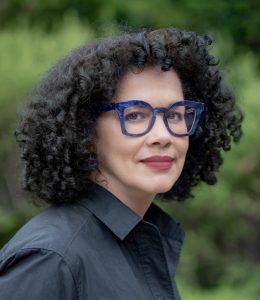
Photo: Michael Palma Mir
Elia Alba was born in Brooklyn to parents who immigrated from the Dominican Republic in the 1950s. She is a multidisciplinary artist whose artistic practice is concerned with the social and political complexity of race, identity, and the collective community. She received her Bachelor of Arts degree from Hunter College in 1994 and completed the Whitney Independent Study Program in 2001. She has exhibited throughout the United States and abroad, including at the Studio Museum in Harlem, El Museo del Barrio, Stedelijk Museum, Amsterdam, Science Museum, London, Smithsonian Museum of Art, National Museum of Art, and Reina Sofía, Madrid. Awards include the Studio Museum in Harlem Artist-in-Residence Program in 1999; Pollock-Krasner Foundation Grant in 2002; Joan Mitchell Foundation Grant in 2002 and 2008; Anonymous Was a Woman Award in 2019; and Latinx Artist Fellowship in 2021. Her work is in the collections of the Smithsonian Museum of Art, El Museo del Barrio, and Lowe Art Museum. Her work has been reviewed in The New York Times, Artforum, ArtNews, and Forbes, among others. Her book, Elia Alba, The Supper Club (2019) brings together artists, scholars, and performers of diasporic cultures through photography, food, and dialogue to examine race and culture in the United States. She was part of the curatorial team for El Museo del Barrio’s critically acclaimed exhibition, Estamos Bien: La Trienal 20/21. She lives and works in the Bronx.
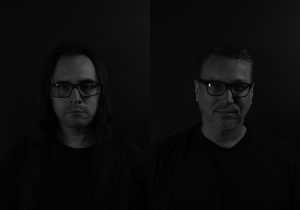
Postcommodity is an interdisciplinary art collective comprised of Cristóbal Martínez (Mestizo), and Kade L. Twist (Cherokee). Postcommodity’s art functions as a shared Indigenous lens and voice to engage the assaultive manifestations of the global market and its supporting institutions, public perceptions, beliefs, and individual actions that comprise the ever-expanding, multinational, multiracial, and multiethnic colonizing force that is defining the twenty-first century through ever-increasing velocities and complex forms of violence. Postcommodity works to forge new metaphors capable of rationalizing our shared experiences within this increasingly challenging contemporary environment; promote a constructive discourse that challenges the social, political, and economic processes that are destabilizing communities and geographies; and connect Indigenous narratives of cultural self-determination with the broader public sphere.
Postcommodity are the recipients of grants from the Joan Mitchell Foundation (2010), Creative Capital (2012), Art Matters (2013), Native Arts and Cultures Foundation (2014), Mid Atlantic Arts Foundation (2017), Ford Foundation Art of Change Fellowship (2017–18), Harker Fund of the San Francisco Foundation (2018–19), Native Arts and Cultures Foundation Shift Award (2021), and Hewlett 50 Arts Commissions (2022). The collective has been exhibited nationally and internationally, including at Contour: 5th Biennial of the Moving Image, Mechelen, Belgium; Nuit Blanche, Toronto; Adelaide International 2012, Adelaide, Australia; 18th Biennale of Sydney, Sydney; Scottsdale Museum of Contemporary Art; 2017 Whitney Biennial; Art in General, New York; documenta 14; 57th Carnegie International, Pittsburgh; Desert X, Coachella Valley, CA; Art Institute of Chicago; LAXART, Los Angeles; Minneapolis Institute of Art; Remai Modern Museum, Saskatoon, Canada. Their historic Land Art installation Repellent Fence occurred at the US/Mexico border near Douglas, Arizona and Agua Prieta, Sonora, Mexico. The collective was awarded the Fine Prize for From Smoke and Tangled Waters, They Carried Fire Home, commissioned for the 57th Carnegie International.
Postcommodity acknowledges the important contributions of its previous collaborators: Steven Yazzie (2007–2010), Nathan Young (2007–2015), Raven Chacon (2009–2018), Adam Ingram-Goble (Game Remains), Andrew McCord (If History Moves at the Speed of Its Weapons, Then the Shape of the Arrow is Changing, and Promoting a More Just, Verdant and Harmonious Resolution), Annabel Wong (Dead River) and Existence AD (Dead River).
CAA’s Annual Artist Interviews will be held on Friday, February 17, 4:30–7 p.m. ET, in Grand Ballroom East.
The 111th CAA Annual Conference will be held February 15–18, 2023 at the New York Hilton Midtown. Register now!
CAA Issues Statement On Hamline University Termination of Dr. Erika López Prater
posted by CAA — Jan 18, 2023
CAA has been following the termination of Professor Erika López Prater at Hamline University. As of last Friday, the Board of Trustees at the university has been engaged in a review of institutional policies, including those focused on academic freedom and inclusion. CAA strongly urges the Board and the administration to uphold the tenets of academic freedom with respect to Dr. López Prater for their public statements that have defamed and damaged her person and her professional reputation.
Academic freedom is a core principle of both Hamline University’s mission and CAA’s charter, and Dr. López Prater’s termination is a tacit rejection of everything that principle stands for in higher education. Beyond an infringement on academic freedom, Hamline’s actions are a dangerous precedent of academic administrators endorsing one side of a religious controversy.
Hamline University’s characterization of Dr. López Prater’s action as “Islamophobic” contradicts widely held definitions of the term from prominent public interest advocacy groups, including the national organizations CAIR (Council on American-Islamic Relations), and MPAC (Muslim Public Affairs Council). Dr. López Prater met and exceeded pedagogical standards for teaching by providing advance written and verbal notice of the intention to illustrate her lecture with two images of the Prophet Muhammed. Additionally, the images she used are historic and symbolic works of art of significance, essential to teaching the long and rich art history of Islam.
CAA calls upon Hamline University, President Fayneese Miller, and AVP David Everett to apologize to Dr. López Prater formally and publicly. Furthermore, this would be the appropriate time to affirm their commitment to both the informed pedagogy that Dr. López Prater demonstrated, and the academic freedom to pursue truth that all professors should expect. CAA speaks on behalf of a membership base that is facing increasingly precarious standards of employment—which is the very reason Hamline University was so easily able to terminate Dr. López Prater. Amends would be made if they recommitted to a tenure-line position for the teaching of art history.
Additional Signatories:
American Sociological Association
Other Statements of Support:
Academic Freedom Alliance (AFA)
Mesa (Middle Eastern Studies Association)


